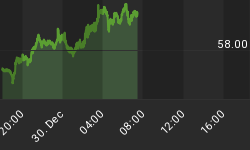A 3-dimensional approach to technical analysis
Cycles - Structure - Price projections
"By the Law of Periodical Repetition, everything which has happened once must happen again, and again, and again -- and not capriciously, but at regular periods, and each thing in its own period, not another's, and each obeying its own law ... The same Nature which delights in periodical repetition in the sky is the Nature which orders the affairs of the earth. Let us not underrate the value of that hint." -- Mark Twain
Because of time constraints, this will be an abbreviated version of the weekly newsletter.
A Review of the Past Week
The QQQQ is the only index which has really conformed to the anticipated consolidation, with the other NASDAQ components behaving similarly. But all other indexes have been under the influence of seasonal tendencies and have pushed a little higher with the Dow Industrials making a new high for the year and the Dow transports reaching an all-time high. Now the argument will be whether the DJIA has confirmed the DJTA under the Dow theory, or if it is a non-confirmation because the one has made a new all-time high and the other has not. I suspect that one will choose sides depending on one's bullish or bearish agenda.
Current Position of the Market.
SPX: Long Term Trend - The long term trend turned up in October 2002 in conjunction with the 12-year cycle. It is now reinforced by the 10-year cycle. A top is likely in 2005.
SPX: Intermediate Trend - The intermediate up trend is still in progress, but it may soon begin to correct into the end of January before pushing higher.
SPX: The Short-term trend could delay its correction until after the "January effect" has run its course.
Because of market volatility, the short term trend is better analyzed on a daily basis with the help of hourly charts. This is done in our daily market updates and Closing Comments.
Daily market analysis: If you would like to receive an explanation of how I arrive at buy and sell signals and be notified on the day that they occur, please let me know at ajg@cybertrails.com.
Also, please read the important notice at the end of this letter.
What's next?
The daily chart of the SPX which appears below illustrates the intermediate term trend which began in August 2004. There is a well defined channel, and prices have recently been confined to the upper half of the channel. This action will not continue forever and sooner or later there will be a break out either through the upper trend line or the middle trend line.
Technical and cyclic considerations favor breaking below the middle trend line after the period of year-end influence has passed.
The fact that prices have been trading in the upper half of the channel represents market strength, and even if prices were to drop into the lower half, it would be a normal correction which could extend to the lower channel line, but would be unlikely to break through right away.
This is confirmed by the MACD -- below the price chart -- which indicates deceleration in the trend, but is not in a position to give an intermediate sell signal from this level.
Charts
SUMMARY:
The year-end tendency continues to influence the price action of the major indexes. Although the indicators have been flashing negative warnings for a while, prices have not been able to reverse. This could happen in early January.
IMPORTANT NOTICE:
If you have visited my website recently, you must know that the "SUBSCRIBE" area has been activated.
Beginning on January 1, 2005, upon request, readers not previously enrolled will be entitled to the daily market comments FREE for a 6-week trial period. After that time has expired, they can choose to subscribe on a yearly or quarterly basis.
Full details are available on the website "SUBSCRIBE" section, including a choice of yearly or quarterly subscription terms.
After the first of the year, this newsletter will be published every other week.
















